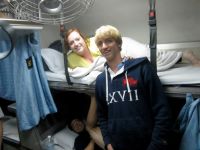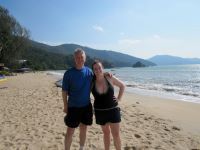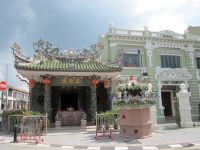
Some like it hot, one of the students reminded me, was a movie set in a sleeper train car that resembled the one that took us on our 22-hour ride from Bangkok to Penang, our first stop in Malaysia. It might also refer to the weather, which is hot and humid—really hot and humid, almost what I understand you’re about to get at home.
28 hours ago we were visiting the Weekend Market in Bangkok, a sprawling center that houses small shops selling everything from cute dogs to pewter buddhas and everything in between. Professor Sikora and I took advantage of the eateries there to sample squid satay (barbequed squid on a stick) and we took advantage of public transportation to get there; Bangkok has a highly-developed skytrain system, which allows you to look down on stalled traffic—and feel like a local because you can navigate by yourself. We did take a cab back to the hotel to make sure we got back in time because we were leaving for Malaysia at 1 pm.
The train ride, as I mentioned, was about 22 hours, which included time to navigate a border crossing and a customs/immigration check that led to two stamps in our passports. The air-conditioned ride got us about 8 degrees closer to the equator, and a direct distance of almost 600 miles, although if you look at the map, you’ll see that we made a dog-leg turn that probably  makes it closer to 700 miles. When we got here, we came to the Bayside Resort Hotel which is at Batu Fehringi (foreign beach), a good 15 minutes from historic Georgetown, but in a rather posh part of the island along the ocean. We had enough time for most students to take advantage of the ocean or the pool—or both. Our introduction to Georgetown consisted of a tricycle ride (the bike apparatus is behind a two-wheeled cart) that took us around some of the historic area to our Chinese restaurant. Tomorrow we’ll get the day tour after our visit to the Dell laptop facility before our flight to Kuala Lumpur.
makes it closer to 700 miles. When we got here, we came to the Bayside Resort Hotel which is at Batu Fehringi (foreign beach), a good 15 minutes from historic Georgetown, but in a rather posh part of the island along the ocean. We had enough time for most students to take advantage of the ocean or the pool—or both. Our introduction to Georgetown consisted of a tricycle ride (the bike apparatus is behind a two-wheeled cart) that took us around some of the historic area to our Chinese restaurant. Tomorrow we’ll get the day tour after our visit to the Dell laptop facility before our flight to Kuala Lumpur.
The differences between Thailand and Malaysia are apparent even from the train (which goes through some of the worst parts of towns, just like in the U.S.) Thailand is about 95% Buddhist, reflected in the number of Wats (temples); Malaysia is about 60% Malay and Muslim, reflected in the mosques (although the 30% Chinese are concentrated in some of the cities, including Penang and Malacca, which historically were part of the “Straits Settlements”, together with Singapore, rather than one of the Sultanates; the sultanates still exist, and one of the sultans becomes King of Malaysia every five years).
There’s a lot more wealth apparent in Malaysia; the CIA factbook gives an income of over 14,000 for Malaysia, about 6,000 more than Thailand. In addition, only 13% of the workforce is in agriculture, which contributes 9% of GDP, a closer correlation than in Thailand. I remember going on this ride in 1997 with my son David. I was reading Megatrends Asia, which extolled Malaysia as a progressive Muslim country, which was considering a major infrastructure loan of over 400$ B to India. It owes a lot to the strong rule of Mahathir Mohammed, who was prime minister almost as long as Lee Kwan-yew, his equally strong counterpart in Singapore.
Penang was and is one of my favorite cities, with its strong heritage mix of ethnicities and the presence of a lot of colonial architecture; the stately British government buildings surrounding the maidan (a parade field), with a clocktower the grateful citizens built in honor of Queen Victoria’s Jubilee; Fort Cornwallis (he became governor of India after Yorktown), reflecting t he importance of Penang at the entrance to the Straits of Malacca, currently and historically one of the most important trade routes for East-West commerce; the shop houses with the second floor extending over the street, allowing pedestrians to be sheltered from heat and rain; homes of the rich families still preserved today.
he importance of Penang at the entrance to the Straits of Malacca, currently and historically one of the most important trade routes for East-West commerce; the shop houses with the second floor extending over the street, allowing pedestrians to be sheltered from heat and rain; homes of the rich families still preserved today.
Tomorrow we’re touring the Dell factory, then, after a tour of historic Penang, we will take a plane ride (happily) to Kuala Lumpur, until recently, the capital of Malaysia and still its most important commercial hub.